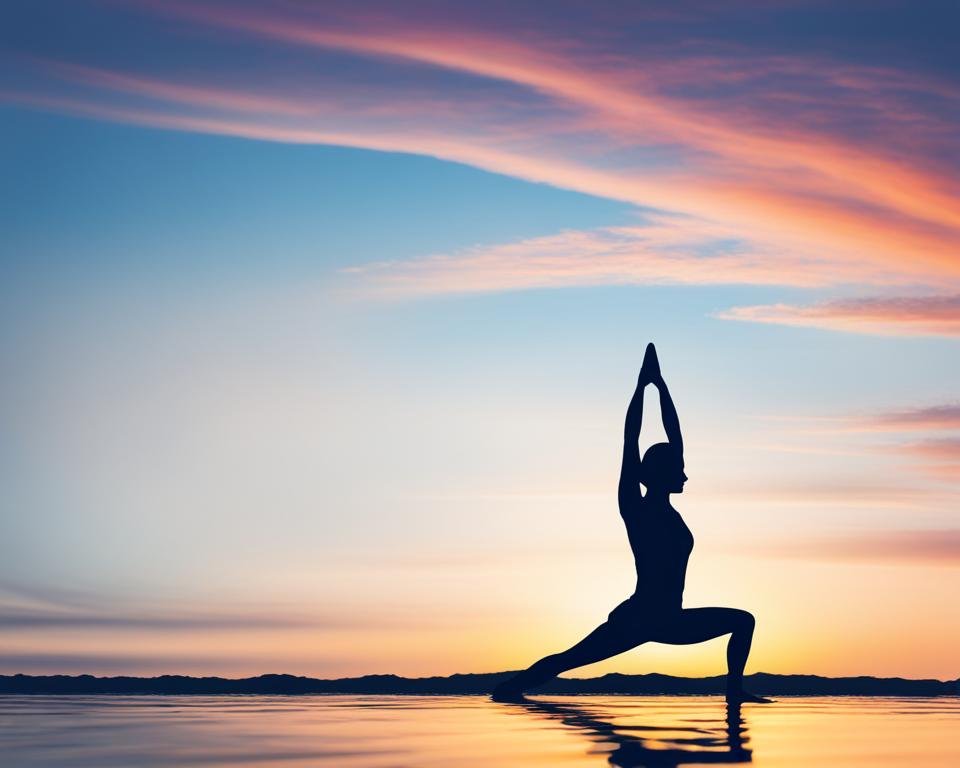Are you looking for a transformative practice that can enhance your physical health, mental clarity, and emotional well-being? Look no further than yoga. With its origins dating back thousands of years, yoga has gained immense popularity worldwide for its wide range of benefits. Whether you’re a beginner or an experienced practitioner, yoga offers something for everyone.
Yoga is not just a physical exercise; it is a holistic approach to wellness that incorporates movement, breath control, and mindfulness. By integrating these elements into your daily routine, you can experience profound positive changes in various aspects of your life.
Key Takeaways:
- Practicing yoga can enhance your physical health, mental clarity, and emotional well-being.
- Yoga offers a wide range of benefits, including increased flexibility, improved cardiovascular health, and stress reduction.
- Mindfulness techniques and breathing exercises in yoga can improve focus and concentration.
- Yoga can promote emotional balance, self-awareness, and anxiety management.
- Specific yoga techniques and poses can help you relax, alleviate stress, and improve sleep quality.
Physical Health Benefits of Yoga

Practicing yoga regularly can have significant positive impacts on your physical health. Not only does it offer a wide range of health benefits, but it also promotes overall fitness and well-being. Let’s explore some of the ways in which yoga can benefit your body.
Increased Flexibility
Yoga is renowned for its ability to increase flexibility. Regular practice helps to stretch and lengthen your muscles, making everyday movements easier and reducing the risk of injuries. Improved flexibility also enhances your range of motion, allowing you to perform tasks with greater ease and efficiency.
Strength Building
Yoga is a full-body workout that engages and strengthens various muscle groups. From balancing poses that target your core muscles to standing poses that strengthen your legs, yoga helps build overall strength and stability. As you progress in your practice, you’ll notice increased muscle tone and a stronger physique.
Improved Cardiovascular Health
While yoga may not be as intense as traditional cardio exercises, such as running or cycling, it can still have a positive impact on your cardiovascular health. Dynamic styles of yoga, such as Vinyasa or Power Yoga, can elevate your heart rate and improve circulation. These practices stimulate the cardiovascular system, helping to strengthen your heart and lower the risk of cardiovascular diseases.
Enhanced Breath Control
One of the fundamental aspects of yoga is breath control. Through specific breathing techniques, known as pranayama, yoga helps you develop greater lung capacity and oxygenation. This can lead to improved respiratory function, increased energy levels, and a heightened sense of well-being.
Restorative Benefits
Yoga offers restorative benefits that can aid in the recovery from physical ailments or injuries. Gentle and supported poses, coupled with mindful breathing, promote relaxation and a sense of calmness. This can help reduce muscle tension, alleviate chronic pain, and improve overall physical comfort.
By incorporating yoga into your fitness routine, you can experience these physical health benefits and more. Whether you’re looking to increase flexibility, build strength, or improve cardiovascular health, yoga provides a holistic approach to enhancing your body’s well-being.
Mental Clarity and Focus

When it comes to enhancing your mental clarity and focus, yoga can be a game-changer. This ancient practice goes beyond physical postures and embraces mindfulness techniques and breathing exercises that can help calm your mind and sharpen your concentration.
One of the key aspects of yoga for mental clarity is learning to be present in the moment. By focusing on your breath and the sensations in your body during yoga practice, you cultivate a sense of mindfulness that carries over into your daily life. This allows you to let go of distractions and engage fully in whatever task or situation you find yourself in.
Participating in yoga also offers a space for reflection and introspection. As you move through the poses, you become more aware of your thoughts and emotions. This self-awareness contributes to a clearer mind and a deeper understanding of yourself.
Furthermore, yoga incorporates specific breathing techniques, known as pranayama, which can have a profound impact on your mental state. For example, deep diaphragmatic breathing activates the parasympathetic nervous system, promoting relaxation and reducing stress. By practicing pranayama regularly, you can develop better control over your breath, enabling you to find calmness and focus even in challenging situations.
Yoga is the journey of the self, through the self, to the self.
– The Bhagavad Gita
As you embark on your yoga journey for mental clarity and focus, consider exploring the following mindfulness techniques:
- **Body Scan**: This practice involves mentally scanning your body from head to toe, noticing any areas of tension or discomfort and consciously relaxing them.
- **Focused Attention Meditation**: As the name suggests, this meditation involves directing your attention to a single point, such as your breath or a specific object, and continuously bringing your focus back whenever your mind wanders.
- **Mantra Meditation**: By repeating a sacred word or phrase (mantra), you can anchor your mind and prevent it from being carried away by distracting thoughts.
Embrace yoga as a tool to cultivate mental clarity and focus. Allow yourself the opportunity to tune inwards, become more present, and discover the transformative benefits of this ancient practice.
Emotional Well-being

Yoga isn’t just about physical exercise; it is a transformative practice that extends to our emotional well-being. By incorporating yoga into your routine, you can experience a multitude of benefits that promote emotional balance, stress relief, and overall mental wellness.
One of the key ways in which yoga supports emotional well-being is through stress reduction. The practice of yoga involves deep breathing, gentle stretching, and mindfulness, all of which help activate the body’s relaxation response and calm the mind. By practicing yoga regularly, you can effectively manage stress levels, reducing the negative impact it has on your emotional state.
Another notable benefit of yoga is its ability to help manage anxiety. By focusing on the present moment and engaging in the physicality of yoga poses, individuals can find relief from anxious thoughts and cultivate a sense of calm. As a result, yoga can significantly reduce symptoms of anxiety and provide a natural alternative to medication.
In addition to stress and anxiety management, yoga also enhances self-awareness. By connecting mind, body, and breath, yoga allows individuals to tune in to their emotions, thoughts, and physical sensations. This heightened self-awareness can lead to better understanding and acceptance of oneself, fostering emotional well-being and personal growth.
Cultivating Emotional Balance
Yoga empowers individuals to find emotional balance by creating a space for self-reflection and introspection. Through the practice of yoga, individuals can develop the tools to navigate and regulate their emotions effectively. By incorporating specific poses and breathing techniques targeted towards emotional release and balance, yoga becomes a powerful tool for emotional healing.
“Yoga is the journey of the self, through the self, to the self.”
– The Bhagavad Gita
Benefits of Yoga for Emotional Well-being
- Stress reduction and management
- Anxiety relief
- Increased self-awareness
- Emotional balance and regulation
- Enhanced mindfulness
- Improved mood and overall well-being
By incorporating yoga into your daily routine, you can tap into these emotional well-being benefits and experience a profound positive shift in your mental and emotional state. Take the first step towards greater emotional balance and peace of mind by embracing yoga as a holistic practice for overall well-being.
| Yoga Poses for Emotional Well-being | Description |
|---|---|
| Child’s Pose (Balasana) | A calming pose that promotes relaxation and relieves stress and anxiety. |
| Legs-Up-The-Wall Pose (Viparita Karani) | Supports rest and rejuvenation, reducing fatigue and promoting emotional balance. |
| Corpse Pose (Savasana) | A final relaxation pose that helps release tension and promotes deep relaxation and emotional well-being. |
Yoga for Stress Relief and Relaxation

When life gets overwhelming and stress starts to take a toll on your well-being, practicing yoga can be a powerful tool for finding relief and achieving a state of relaxation. Yoga offers specific techniques and poses that help calm the mind, release tension, and restore balance to both the body and the mind.
One of the key connections between yoga and stress reduction is breath control. By consciously focusing on your breath during yoga practice, you activate the body’s relaxation response. This triggers a series of physiological changes, such as a decrease in heart rate and blood pressure, inducing a state of relaxation and tranquility.
Restorative yoga, in particular, is highly effective in promoting deep relaxation. It involves gentle, supported poses that allow the body to fully relax and release tension. Some of the common restorative yoga poses include Legs-Up-The-Wall pose (Viparita Karani), Supported Child’s Pose (Balasana), and Reclining Bound Angle Pose (Supta Baddha Konasana).
By dedicating even just a few minutes each day to yoga for relaxation, you can experience a profound shift in your stress levels and overall well-being. Take a break from the chaos of life, slow down, and give yourself the gift of inner peace through the practice of yoga.
The Benefits of Yoga for Stress Relief:
- Reduces stress hormones like cortisol
- Boosts mood and promotes feelings of calmness
- Improves sleep quality
- Enhances mental clarity and focus
- Promotes a sense of overall well-being
It’s time to prioritize self-care and make yoga for stress relief and relaxation an integral part of your daily routine. Let go of stress, find inner peace, and embrace a healthier, more balanced life through the transformative power of yoga.
Improving Sleep Quality with Yoga

Yoga not only benefits our physical health and mental well-being but also plays a significant role in improving sleep quality and managing insomnia. By incorporating yoga into your bedtime routine, you can create a peaceful environment for your body and mind to relax and prepare for a restful night’s sleep.
Bedtime yoga routines focus on gentle movements and calming breathing exercises that promote relaxation and help release tension from the day. These practices can quiet the mind, reduce stress, and alleviate anxiety, allowing you to enter a state of deep relaxation and tranquility.
Bedtime Yoga Poses for Better Sleep
Here are some of the best yoga poses you can try before bedtime to improve your sleep quality:
- Child’s Pose (Balasana): This restorative pose helps release tension in the back, shoulders, and neck, promoting relaxation and calming the nervous system.
- Legs Up the Wall Pose (Viparita Karani): By placing your legs up against a wall, you can improve circulation, reduce swelling in the legs, and induce a sense of calmness.
- Corpse Pose (Savasana): This pose involves lying flat on your back and consciously relaxing each part of your body, allowing yourself to fully unwind and let go.
By incorporating these poses into your bedtime routine, you can enhance your sleep quality and establish a sense of calm before drifting off to sleep.
“Yoga is a powerful tool for calming the mind and preparing the body for restful sleep. The practice of yoga helps release physical tension and mental stress, promoting a deeper and more rejuvenating sleep experience.”
Relaxation Techniques for Better Sleep
In addition to bedtime yoga poses, incorporating relaxation techniques into your nighttime routine can further enhance sleep quality:
- Pranayama Breathing: Deep breathing exercises, such as alternate nostril breathing or 4-7-8 breathing, can activate the body’s relaxation response and help you unwind before sleep.
- Meditation: Practicing mindfulness and meditation can quiet the mind, reduce racing thoughts, and promote a sense of calmness and tranquility.
By combining these relaxation techniques with bedtime yoga poses, you can create a soothing pre-sleep ritual that prepares your body and mind for a restorative night’s sleep.
| Benefits of Yoga for Better Sleep | Benefits |
|---|---|
| Reduces stress and anxiety | Promotes relaxation and calmness |
| Relieves physical tension | Helps the body unwind before sleep |
| Improves circulation | Enhances overall sleep quality |
| Quiets the mind | Reduces racing thoughts |
By incorporating yoga into your evening routine and utilizing relaxation techniques, you can experience the transformative benefits of yoga for better sleep. Start incorporating these practices tonight to enjoy a more restful and rejuvenating slumber.
Yoga for Back and Neck Pain Relief

If you suffer from persistent back and neck pain, incorporating yoga into your wellness routine can provide therapeutic relief and improve your overall spinal health. Yoga offers gentle stretching exercises and poses that specifically target the muscles and structures of the back and neck, helping to alleviate tension and promote healing.
Yoga for Back Pain:
The practice of yoga can effectively address back pain by strengthening the supporting muscles, improving flexibility, and promoting proper alignment of the spine. Specific yoga poses, such as Cat-Cow, Cobra, and Bridge, can help stretch and strengthen the back muscles, release tension, and relieve discomfort. The controlled movements and deep breathing involved in yoga help improve circulation, which facilitates the healing process and reduces inflammation.
Yoga for Neck Pain:
Neck pain often stems from poor posture, stress, and muscle imbalances. Yoga can provide relief by targeting these factors and promoting relaxation and rejuvenation of the neck muscles. Poses like Child’s Pose, Standing Forward Bend, and the seated neck stretch can help release tension, improve posture, and increase neck flexibility. Incorporating breathing techniques and mindful movements into your yoga practice can ease mental stress, which often contributes to neck pain.
Regular practice of yoga for back and neck pain can lead to significant improvement in discomfort, increased range of motion, and better spinal alignment. However, it is essential to consult with a qualified yoga instructor or medical professional before starting any new exercise regimen, especially if you have pre-existing health conditions or injuries.
By incorporating yoga into your daily routine, you can effectively manage back and neck pain, improve your posture, and enhance your overall well-being. The holistic approach of yoga addresses both the physical and mental aspects of pain, offering long-lasting relief and promoting a healthier lifestyle.
Yoga for Posture and Body Alignment

Proper posture and body alignment are crucial for maintaining a healthy and pain-free life. Fortunately, yoga offers a holistic approach to improving posture by focusing on strengthening core muscles, lengthening the spine, and promoting better alignment throughout the body.
By incorporating yoga into your fitness routine, you can develop awareness of your body’s positioning and make conscious adjustments to correct any imbalances. Regular practice of yoga poses that target specific muscle groups can help strengthen weak areas and release tension in tight muscles, allowing for improved posture and alignment.
Some of the key yoga poses that can enhance posture and body alignment include:
- Mountain Pose (Tadasana): This foundational pose establishes a strong and upright posture, aligning the spine, shoulders, and hips. It promotes a sense of balance and stability.
- Bridge Pose (Setu Bandhasana): By strengthening the back muscles and opening the chest, this pose helps counteract the effects of prolonged sitting and slouching.
- Warrior II (Virabhadrasana II): This pose strengthens the lower body, hips, and core, while also opening the chest and shoulders. It promotes a tall spine and encourages a confident, grounded posture.
- Tree Pose (Vrikshasana): By improving balance and stability, this standing pose engages the core muscles and encourages an upright posture. It also provides an opportunity to focus and calm the mind.
Regular practice of these poses, along with a mindful approach to body awareness, can lead to improved posture, body alignment, and overall well-being. Additionally, incorporating breathing exercises and meditation into your yoga practice can further support relaxation and body-mind connection.
Experience the transformative benefits of yoga for posture and body alignment. Achieve a confident and upright posture that radiates both strength and grace, improving your overall physical appearance and well-being.
Yoga for Weight Management

When it comes to weight management, yoga offers a holistic approach that goes beyond just physical exercise. By combining specific styles of yoga with mindful eating practices, individuals can achieve healthy weight loss or maintain their current weight.
Yoga for weight loss focuses on strengthening and toning the body, increasing metabolism, and improving overall physical fitness. Vinyasa yoga, for example, combines flowing movements with synchronized breath, creating a dynamic workout that can help burn calories and build lean muscle mass.
On the other hand, yoga for weight maintenance emphasizes balance and mindfulness. Restorative yoga, with its gentle and relaxing poses, can help reduce stress and emotional eating, promoting sustainable weight management. By cultivating a regular yoga practice and paying attention to the body’s cues, individuals can develop a healthier relationship with food and make nourishing choices.
It is important to note that while yoga can be a valuable tool for weight management, it should not be the sole focus. A well-rounded approach that includes a balanced diet, regular physical activity, and proper rest is essential for overall well-being.
“Yoga is not a weight loss program, but it can support individuals in their weight management journey by promoting mindfulness, self-awareness, and body acceptance.”
– Yoga instructor, Sarah Thompson
The Benefits of Yoga for Weight Management
By incorporating yoga into their weight management routine, individuals can experience several benefits:
- Improved body awareness and self-image
- Enhanced muscle tone and flexibility
- Increased metabolism and calorie burn
- Reduced stress, which can contribute to emotional eating
- Better digestion and elimination
Yoga can also provide individuals with a sense of empowerment and self-care, encouraging them to make healthier choices in all aspects of their lives.
| Yoga Style | Main Focus | Benefits |
|---|---|---|
| Vinyasa Yoga | Dynamic movements and synchronized breath | Increased calorie burn, improved cardiovascular health, enhanced strength and flexibility |
| Restorative Yoga | Gentle and relaxing poses | Reduced stress and emotional eating, improved sleep quality, enhanced body awareness |
| Hatha Yoga | Balance through physical postures and breath control | Improved muscle tone, increased flexibility, reduced stress |
Yoga as an Anti-Aging Tool

Discover how yoga can help slow down the aging process and promote a more youthful appearance. By incorporating specific yoga poses and practices into your daily routine, you can improve circulation, increase flexibility, and support healthy aging.
Improved Circulation
One of the key benefits of yoga for anti-aging is its ability to improve circulation throughout the body. Through yoga poses that focus on deep breathing and gentle stretching, such as the Standing Forward Bend and Legs-Up-the-Wall pose, you can enhance blood flow, deliver oxygen and nutrients to your cells, and promote a healthy glow in your skin.
Increased Flexibility
As we age, our joints and muscles can become less flexible, leading to stiffness and decreased mobility. However, regular yoga practice can help counteract this by improving flexibility. Poses like the Triangle Pose and the Seated Forward Bend work to stretch and lengthen muscles, promoting a supple body and a youthful range of motion.
Supporting Healthy Aging
Yoga is not just a physical practice; it also nourishes the mind and spirit, which plays a vital role in healthy aging. The combination of deep breathing exercises, mindfulness techniques, and relaxation poses in yoga can help reduce stress levels, improve sleep quality, and support emotional well-being. These benefits contribute to a more youthful and vibrant appearance.
As you age, it is important to prioritize self-care and embrace practices that promote overall well-being. Yoga offers a holistic approach to anti-aging, addressing both the physical and mental aspects of aging gracefully. By incorporating yoga into your routine, you can experience the transformative power it holds for a more youthful and radiant you.
Conclusion
Throughout this article, we have explored the transformative uses and benefits of practicing yoga. From physical health improvements to mental clarity and emotional well-being, yoga offers a holistic approach to wellness.
Yoga has been proven to enhance physical health by increasing flexibility, strength, and cardiovascular fitness. It improves mental clarity and focus through mindfulness techniques and breathing exercises. Additionally, yoga promotes emotional well-being by reducing stress, anxiety, and increasing self-awareness.
To experience these benefits, I encourage you to start your wellness journey by incorporating yoga into your daily life. Whether you are a beginner or an experienced practitioner, yoga can provide a positive impact on your overall well-being. Find a local yoga studio or try online classes to explore different styles and techniques that suit your needs.
FAQ
What are the uses of yoga?
Yoga has various transformative uses and benefits. It can enhance your physical health, mental clarity, and emotional well-being.
How does yoga improve physical health?
Practicing yoga can improve physical health by increasing flexibility, strength, and cardiovascular health.
Can yoga help with mental clarity and focus?
Yes, yoga can help improve mental clarity and focus. It incorporates mindfulness techniques and breathing exercises that enhance concentration and mental peace.
What role does yoga play in emotional well-being?
Yoga promotes emotional well-being by reducing stress, managing anxiety, increasing self-awareness, and restoring emotional balance.
Does yoga help with stress relief and relaxation?
Yes, yoga techniques and poses can help relax the body and alleviate stress. Breath control and restorative yoga practices are especially effective for stress reduction.
How can yoga improve sleep quality?
Yoga contributes to improved sleep quality and helps manage insomnia. Bedtime yoga routines and relaxation techniques prepare the body and mind for a restful night’s sleep.
Can yoga relieve back and neck pain?
Yes, yoga has therapeutic benefits for relieving back and neck pain. Gentle stretching exercises and poses can alleviate tension and improve spinal health.
Is yoga beneficial for posture and body alignment?
Practicing yoga improves posture and body alignment. Specific poses and techniques strengthen core muscles, lengthen the spine, and promote better alignment.
Can yoga help with weight management?
Yes, yoga plays a role in weight management. Certain styles of yoga, combined with mindful eating practices, support healthy weight loss or weight maintenance goals.
Does yoga have anti-aging benefits?
Yes, yoga can help slow down the aging process and promote a more youthful appearance. Specific poses and practices improve circulation, increase flexibility, and support healthy aging.




